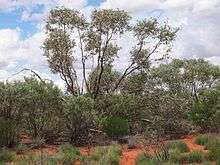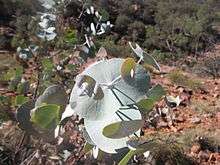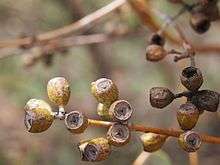Eucalyptus gamophylla
Eucalyptus gamophylla, commonly known as warilu, blue-leaved mallee,[2] twin-leaf mallee,[3] twin-leaved mallee or blue mallee,[4] is a species of mallee that is native to Western Australia, South Australia and the Northern Territory. It usually has smooth bark, mostly only juvenile leaves arranged in opposite pairs, flower buds in groups of three, whitish flowers and cylindrical to barrel-shaped fruit that is four-sided in cross-section.
| Warilu | |
|---|---|
 | |
| Eucalyptus gamophylla habit | |
| Scientific classification | |
| Kingdom: | Plantae |
| Clade: | Tracheophytes |
| Clade: | Angiosperms |
| Clade: | Eudicots |
| Clade: | Rosids |
| Order: | Myrtales |
| Family: | Myrtaceae |
| Genus: | Eucalyptus |
| Species: | E. gamophylla |
| Binomial name | |
| Eucalyptus gamophylla | |


Description
Eucalyptus gamophylla is mallee that typically grows to a height of 1.5 to 7 metres (5 to 23 ft) and forms a lignotuber but sometimes has an almost prostrate habit. It usually has smooth white, cream-coloured or brown bark that is shed in short ribbons but there is sometimes a stocking of rough, hard, stringy-fibrous bark at the base. Most of its leaves are juvenile, sessile, arranged in opposite pairs sometimes with their bases joined, glaucous, egg-shaped to heart-shaped, 35–100 mm (1.4–3.9 in) long and 20–60 mm (0.79–2.36 in) wide. Adult leaves, when present, are more or less in opposite pairs, the same dull, greyish green on both sides, sessile, 40–100 mm (1.6–3.9 in) long and 9–20 mm (0.35–0.79 in) wide on a petiole 1–6 mm (0.039–0.236 in) long.[2][3][4][5][6][7][8]
The flower buds are arranged in groups of three on a peduncle 5–10 mm (0.20–0.39 in) long, the individual buds on pedicels 1–3 mm (0.039–0.118 in) long. Mature buds are club-shaped to pear-shaped, 4–7 mm (0.16–0.28 in) long and 3–4 mm (0.12–0.16 in) wide with a rounded operculum. Flowering occurs in most months, depending on habitat and in some places follows rain. The flowers are whitish and the fruit is a woody conical, cylindrical, bell-shaped or barrel-shaped capsule four-sided in cross-section, 5–14 mm (0.20–0.55 in) long and 5–8 mm (0.20–0.31 in) wide.[2][3][4][5][6][7][8]
Taxonomy and naming
Eucalyptus gamophylla was first formally described by the botanist Ferdinand von Mueller in 1878 in his book Fragmenta Phytographiae Australiae. The type specimen was collected by John Forrest from Mount Pyrten in the Hamersley Range and cited as In monte Pyrten tractus Hammersley-Range, altitudine 2,500' supra mare.[9][10] According to Francis Aubi Sharr, the specific epithet (gamophylla) is derived from the ancient Greek gamos meaning "marriage" and -phyllus meaning "-leaved", referring to the bases of the opposite leaves being joined.[11] A Greek–English Lexicon of Liddell, Scott and Jones give gamos (γάμος) as the ancient Greek word for "wedding", "marriage" or "wedlock".[12]:337 and phyllon (φύλλον) as "leaf".[12]:1962
Range
Warilu is found on sandplains and sand dunes and in stony spinifex country. It has a range extending from the Mid West, Pilbara and Goldfields-Esperance regions of central Western Australia,[3] then extending east into central and southern areas of the Northern Territory[13] and the far north of South Australia.[14] Species commonly associated with E. gamophylla include Triodia basedowii, Acacia ligulata, Acacia georginae, Eremophila longifolia and Eragrostis eriopoda.[15]
Cultivation
Eucalyptus gamophylla is drought tolerant and hardy in the cold, able to tolerate temperatures as low as 10 to 15 °F (−12 to −9 °C)[16] and is frost tolerant. When cultivated for the garden, it is bird attracting,[13] fast growing, requires very little maintenance and can provide plenty of aromatic cut foliage for flower arrangements.[16]
See also
References
- "Eucalyptus gamophylla". Australian Plant Census. Retrieved 10 July 2019.
- "Eucalyptus gamophylla". Euclid: Centre for Australian National Biodiversity Research. Retrieved 2 June 2020.
- "Eucalyptus gamophylla". FloraBase. Western Australian Government Department of Parks and Wildlife.
- Nicolle, Dean (2013). Native Eucalypts of South Australia. Adelaide: Dean Nicolle. pp. 26–27. ISBN 9780646904108.
- Chippendale, George M. "Eucalyptus gamophylla". Australian Biological Resources Study, Department of the Environment and Energy, Canberra. Retrieved 10 July 2019.
- Todd Erickson; Russell Barrett; David Merritt; Kingsley Dixon (2016). Pilbara Seed Atlas and Field Guide: Plant Restoration in Australia's Arid Northwest. CSIRO publishing. ISBN 9781486305544.
- "Eucalyptus gamophylla (Myrtaceae) Twin-leaved Mallee". Seeds of South Australia. Botanic Gardens of South Australia. Retrieved 16 October 2016.
- "Eucalyptus gamophylla". State Herbarium of South Australia. Retrieved 10 July 2019.
- "Eucalyptus gamophylla". APNI. Retrieved 10 July 2019.
- von Mueller, Ferdinand (1878). Fragmenta phytographiae Australiae. Melbourne: Victorian Government Printer. pp. 40–41. Retrieved 10 July 2019.
- Francis Aubie Sharr (2019). Western Australian Plant Names and their Meanings. Kardinya, Western Australia: Four Gables Press. p. 204. ISBN 9780958034180.
- Liddell, Henry George; Scott, Robert; Jones, Henry Stuart (1940). A Greek-English Lexicon. Oxford: Clarendon Press.
- "Eucalyptus gamophylla". Alice Springs Town Council. Retrieved 16 October 2016.
- "Eucalyptus gamophylla F.Muell". Atlas of Living Australia. Global Biodiversity Information Facility. Retrieved 16 October 2016.
- David A. Keith (2017). Australian Vegetation. Cambridge University Press. ISBN 9781107118430.
- "Eucalyptus gamophylla". plantlust. Retrieved 16 October 2016.